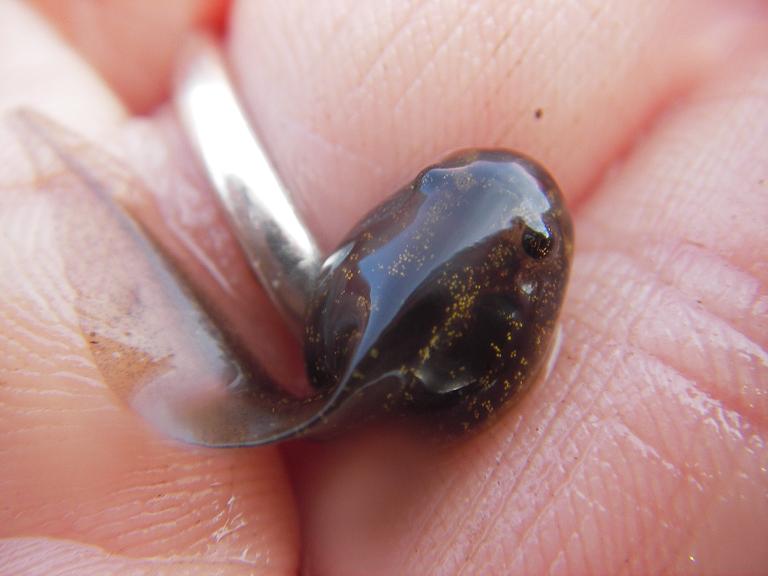Reptiles, amphibians, and freshwater fish of King County
King County is home to many species of reptiles, amphibians, and freshwater fish.
Reptiles
We have only six native reptile species, and three of those are garter snakes. We have at least two non-native reptiles (and probably more).
Native species

A Northwestern Garter Snake
- Common Garter Snake
- Northern Alligator Lizard
- Northwestern Garter Snake
- Rubber Boa
- Western Fence Lizard
- Western Terrestrial Garter Snake
Introduced species
- Painted Turtle
- Slider
Amphibians
We have 11 native amphibian species still present in King County, and 2 non-natives.
Native species
- Cascades Frog
- Long-toed Salamander
- Northwestern Salamander
- Pacific Giant Salamander
- Pacific Treefrog (Pacific Chorus Frog)
- Red-legged Frog
- Roughskin Newt
- Spotted Frog – historically present
- Tailed Frog
- Western Redback Salamander
- Western Toad
Introduced species
- Bullfrog
- Ensatina Green Frog
Our state amphibian: the Pacific Tree Frog
In 2007, the Pacific Tree Frog was named the state amphibian of Washington. Explore the life cycle of this tiny native frog from egg to tadpole to adult.
Freshwater fish
There are approximately 50 species of freshwater fish in King County, and 20 of those are introduced. The native Salmonids—the Pacific salmon, char and whitefishes—are the best known fishes of King County waters. The other freshwater fishes native to King County waters include:
- The Western brook lamprey, a stream-dwelling, diminutive cousin of the larger Pacific lamprey
- White sturgeon, the largest native fish in King County waters and only rarely observed in Lake Washington
- Longfin smelt
- Six members of the Cyprinidae (minnow) family, including three species of dace, one species of shiner, a peamouth chub, and the northern pikeminnow
- Two species of sucker
- Threespine stickleback
- Six species of sculpin
- Starry flounder, a flatfish of brackish river mouths
Featured freshwater fish
Peamouth

A pair of peamouth, one male and one female.
Also known as "peamouth chub" or "peamouth minnow," these fish are in the minnow and carp family and grow to about a foot long. Thousands of peamouth move from Lake Washington to its tributaries every spring in April or May to spawn. They remain there for less than two days before heading back to the lake.
If you happen to look into a stream when they are spawning, you may be shocked at how many fish there are. City of Bellevue's Stream Team has a "Peamouth Patrol," in which volunteers count them each spring!
Threespine stickleback

The threespine stickleback are a small fish found in big and small lakes and streams in King County. Their range is circumpolar in Arctic and temperate regions. Occasionally, die-offs of this plentiful fish occur in Lake Washington; these die-offs are normal.
Interestingly, threespine sticklebacks provide keys to information about genetics and evolution:
- Seattle Times (May 15, 2008): Backward-evolving Lake Washington fish lends clues about genetics
- Seattle Times (Feb. 15, 2009): Darwin's fishes: the threespine stickleback of the Pacific Northwest
Salmon and trout
Many of our salmon and trout species are anadromous. Anadromous fish are born in streams, they migrate to the ocean to feed and grow into mature adults, then they return to their natal stream to spawn. These fish, therefore, are both freshwater and marine species, depending on the time of year.
Of this group, the species of Pacific salmon, members of the genus Oncorhynchus, are by far the most important and iconic. There are 7 species of the genus Oncorhynchus that inhabit King County waters:
- Chinook or king salmon, the largest of the group
- Chum or dog salmon
- Sockeye salmon
- Coho salmon
- Pink salmon
- Steelhead trout
- Coastal cutthroat trout, an inhabitant of even the smallest streams in the county
More salmon and trout resources
- USDA Pacific Northwest Fishery Program's Native salmon & steelhead page
- King County's salmon identification guide
- WRIA salmon conservation plans for WRIA 7, WRIA 8, and WRIA 9
Regulated/protected fish
In addition to many of the salmonids, some freshwater species are also protected.
Pygmy whitefish
The pygmy whitefish is a State Sensitive species that spawns in cold fast-flowing mountain streams that flow into cool lakes, where they rear. Their only population in King County is in the Cedar River above Chester Morse Lake.
Too little is known about this population to know how it is doing relative to pre-logging conditions. However, the vast majority of this watershed, which was historically logged, will no longer be logged. As forest conditions mature, it is assumed the stream conditions will remain the same or improve, which should benefit the pygmy whitefish.
More information about the pygmy whitefish can be found in the Seattle Channel's video, Cedar River Fish: Pygmy Whitefish
Olympic mudminnow
The Olympic mudminnow is a State Sensitive species that is most often found in slow-moving streams and wetlands. This species has been documented in certain streams and wetland ponds in King County. However, King County is thought to be out of its range. It is thought that their presence in county streams is because people have introduced them into the streams, not because of a natural range extension.
View a USGS fact sheet on Olympic Mudminnows
 Translate
Translate






